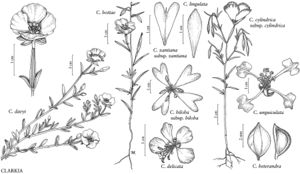Difference between revisions of "Clarkia lingulata"
Madroño 12: 35. 1953.
imported>Volume Importer |
imported>Volume Importer |
||
| Line 47: | Line 47: | ||
|publication year=1953 | |publication year=1953 | ||
|special status= | |special status= | ||
| − | |source xml=https://xjsachs2@bitbucket.org/aafc-mbb/fna-data-curation.git/src/ | + | |source xml=https://xjsachs2@bitbucket.org/aafc-mbb/fna-data-curation.git/src/e39f0e846f172941159b2045254d62d10d9823f6/coarse_grained_fna_xml/V10/V10_410.xml |
|subfamily=Onagraceae subfam. Onagroideae | |subfamily=Onagraceae subfam. Onagroideae | ||
|tribe=Onagraceae tribe Onagreae | |tribe=Onagraceae tribe Onagreae | ||
Latest revision as of 10:32, 9 May 2022
Stems erect, to 60 cm, puberulent. Leaves: petiole to 15 mm; blade linear to narrowly lanceolate, 2–6 cm. Inflores-cences open racemes, axis recurved at tip in bud; buds pendent. Flowers: floral tube 1–4 mm; sepals reflexed together to 1 side; corolla rotate, petals bright pink, red-flecked or not, oblanceolate, 10–20 mm, apex subentire or minutely notched; stamens 8, unequal, outer anthers lavender, inner smaller, paler. Capsules 10–20 mm. Seeds brown, 1 mm, minutely scaly to puberulent, crest inconspicuous. 2n = 18.
Phenology: Flowering May–Jun.
Habitat: Open chaparral.
Elevation: 400–500 m.
Discussion
Clarkia lingulata is listed as endangered by the State of California, known from only a few populations in Merced River Canyon, Mariposa County. It is derived from C. biloba subsp. australis, from which it can be distinguished morphologically by its narrower, unlobed petals; the two taxa also differ in chromosome number, and form only highly sterile hybrids.
Selected References
None.
